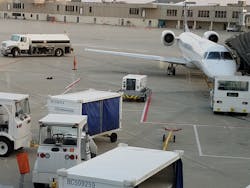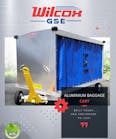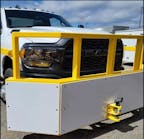Lease or buy? Long-term or short-term? These are questions ground support professionals have had to weigh regarding their equipment purchases for a long time. Truth is, the answers may change and adapt as the industry changes, or as a company grows or contracts.
Today there are a large variety of options for ground support equipment financing, in addition to an assortment of actual equipment.
From purchase options to dollar buy out leases, it pays to work with a professional who knows their stuff and can help ground service providers make the best decision for their needs and financial future.
A New Generation
“We come along and give them five different options and most of the customers will listen, but sometimes it takes a little time to have somebody change the way you do things,” says William R. Long, president of Xced Aviation Services, which after four years in business is at 82 airports nationwide through 60 customers. It offers a variety of flexible leasing options, refurbishment financing as well as traditional fixed-purchase option financing.
Long is referring to the new generation of ground support equipment professionals and the changes they are embracing in the industry. He says Xced is not just in the business of financing, but overall asset management, understanding that ground support professionals need someone to help them manage their equipment needs, from cradle to grave, for their entire lifecycles.
This traditional way of doing business is one Neil Bennett, the national finance manager for TCF Equipment Finance’s Airport Ground Support Equipment Division, is familiar with and agrees is changing. On significant chang is how equipment fleets are financed and TCFEF provides a variety of options for.
Bennett says he was educated to never lease; however, he explains buying outright is not the only solution for GSE needs.
If a new station is starting up, a GSE customer may choose an option to lease the equipment for three years to see if that endeavor is going to work long-term, and then, stagger leases to provide flexibility.
“This decision often is made by senior management who align financial decisions with business strategy,” adds Bennett. “Are they absolutely intent on buying, or maintaining financial flexibility should market conditions change or opportunities present themselves for growth?”
Knowledge is King
Here’s where the candid conversations must take over.
Peter Stearn is the vice president at Fortbrand Services Inc., which has been offering a large GSE fleet of new and used pieces to its clients for more than 30 years. The company sells new equipment, but also rents and leases to clients as needed.
Stearn explains that airline customers with little threat of going out of business soon will tend to purchase new equipment, and he sees little risk in that practice, as they are likely to benefit from the entire useful life of a piece of equipment. In a down economic cycle, however, he’s seen them turn to leasing and renting to keep capital close.
Even though the client may walk in knowing what they want, TCFEF’s Bennett adds that an intelligent conversation about what is prompting them, what issue they may be having, and the operation itself is a must.
“Climate, location, size of operation, we review all those factors,” he says.
One client may be looking to replace old equipment and expand into new markets, while another is under a new three-year contract and needs equipment to match that. Bennett adds other factors to consider include ground power, electrical power, number of baggage carts and maintenance, among many others.
“It makes a big difference if you work with a financing professional who knows the industry,” he says.
He says if a ground support provider simply says they want to lease five electric baggage tractors, and the financial professional offers a low interest rate and secures the payment, but doesn’t ask what the tractors are for, both could be in a world of hurt later on.
“Are they going to be used 24 hours a day at O’Hare or two hours a month somewhere else? The financing professional may not even offer the financial product that meets their needs,” Bennett notes.
“All my people are industry people,” adds Xced’s Long. “We don’t have to teach them what equipment a client would need to service a 737.”
He says that “talking shop” is critical in a successful relationship, and ground support professionals should find a financial group that can do the same.
“We recently completed a client survey and they told us that the reason they prefer doing business with Xced is our industry knowledge,” Long says.
Finding Flexibility
Xced keeps an inventory of approximately 200 pieces of new, used and refurbished equipment, all the basics that will get a client up and running at an airport.
“We try to make sure our customers have the equipment they need, where they need it, when they need it,” notes Long.
He explains that sometimes ground handlers are given 60 days to put a contract in place, which is too soon to have a purchase order placed and fulfilled for new equipment.
“We can generally ship GSE to an airport within 24 hors after receipt of an executed rental or lease agreement,” he says.
Fortbrand’s Stearn adds to this, saying that special events such as the Super Bowl, a NASCAR race, political event, etc., increase the need for a financial provider to provide flexibility.
“There are all sorts of scenarios that arise to give need to a short-term rental,” he says. “We can accommodate any requirement a customer may have.”
“A client may need more or less equipment, to move equipment or may need completely different equipment,” concurs Long. “We have the ability to change on the fly and provide that flexibility.”
He says many of the ground handling companies aren’t in the business of selling equipment or finding another home for a tractor if they don’t need it anymore. But they need flexibility from their financial partner (aka fleet manager) instead.
Flexibility, in Bennett’s mind, does not mean using a line of credit to finance equipment. If an emergency occurs in the business or a need arises to keep the business afloat, the last place you want the money tied up is in daily operational equipment, he says.
“You can fix your problem, and pay that back by using the right financing for the right products,” Bennett says. “Finding the right financing solution is critical.”
He adds to that line of thought by saying that the airline industry is very tumultuous.
“GSE companies are finding new contracts and losing old ones. You can move with the market conditions, and not be stuck with something you have to try and sell,” he says in terms of leasing.
New or Used?
The advantage to owning a piece of equipment is in knowing it will have a long, useful life, which may make sense in long-term contracts for a provider. The lifespan also depends on the buyer’s maintenance on that equipment, Fortbrand’s Stearn explains, adding that the cost of new equipment is changing in terms of the Tier 4 requirement, as well as other add-ons such as the collision avoidance systems.
The flip side, then, is used equipment.
“There’s no rule of thumb,” Stearn says. “Depending on the piece of equipment, what’s been done to it, the age, it could be a significant discount and make a lot of sense to a customer.”
Many times, the ground handling companies prefer this option, versus the airlines, Stearn notes.
In 2016, Xced opened its first refurbishment center in Indianapolis, and Long explains this is what truly helps clients through an equipment lifecycle journey.
“If today the customer needs a tractor to push a 737 around, we provide that tractor,” he says. “But if tomorrow, the contract changes and now he needs to service a 747, we take the tractor back and put a different one in. Financing is part of the equation, but it’s more lifecycle management. Having our own captive refurbishment capabilities along with unlimited financing options provides the ultimate in flexibility for our clients.”
TCFEF’s Bennett adds to this conversation by saying that there are specific types of equipment that provide a better value. What is a good refurbishment? He says if it is just pressure washed, has its tires replaced and then given a new seat, that is not a great definition of refurbishment.
“Or, has the unit been zero-timed?” he asks, and adds that a bad refurbishment can be a hit on the leasing company’s reputation too.
“We’re simply a finance portion of it,” Bennett explains. “But the client might get upset with a product’s reliability and not want to pay for it.”
“I don’t want to get involved in buying someone else’s problem,” Long agrees, saying this is the reason Xced’s refurbishment program has been brought in-house. “We don’t know what level of refurbishment someone else has completed, so we generally avoid the problem by utilizing our own GSE where we know the actual condition of the GSE.”
Final Thoughts
“There are good people at the airlines and ground handling companies,” says Stearn. “Everybody’s trying to do the right thing and share information, help each other out.”
Long agrees. He says people are not looking realistically at GSE equipment if they believe their equipment needs won’t change.
“They will,” he says. “We are in business now with people I never thought we’d get business with, and it’s because they are figuring out that flexibility allows them to better run their business.”
Bennett concludes by saying all of these factors are why a continuous conversation is important for both sides. He encourages GSE providers to ask the tough questions and the financial professionals to ask them back.






